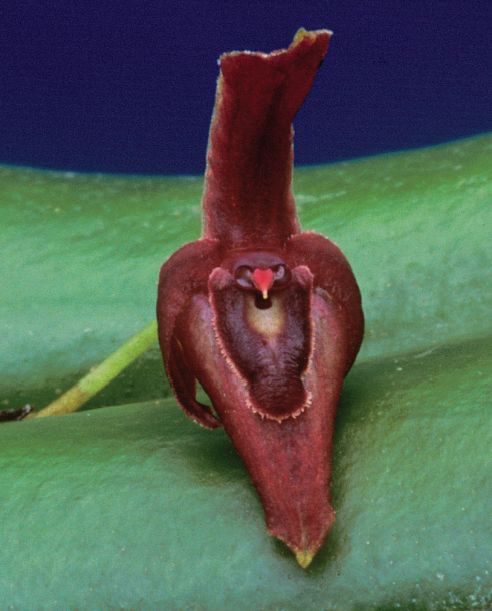

Pleurothallis angusta Ames & C.Schweinf. 1925 SUBGENUS Pleurothallis SECTION Macrophyllae-Fasciculatae Lindl 1859
Photo by Franco Pupulin and Harvard Papers in Botany Vol. 26, No. 1 2021, The Researchgate Website
Drawing of P angusta/harlingii
Drawing by © Carl Luer





Common Name The Narrow Pleurothallis [possibly refers to the narrow, oblong leaves of the species]
Flower Size .8" [2 cm]
Found in Alajuela and Cartago provinces of Costa Rica restricted to the Caribbean watershed of the Cordillera Volcánica Central and the Cordillera de Talamanca in lower montane rain forests to wet montane forests at elevations around 750 to 2100 meters as a medium sized, warm to cold growing, caespitose epiphtye with a terete, erect to suberect, slender, green suffused with dark red ramicaul provided with a tubular, short, truncate sheath to 1" [2.5 cm] long at the base, and a longer, tubular, tightly adpressed, obtuse sheath below the middle and carrying a single, erect at the apex of the ramicaul, becoming horizontal and revolute in the basal half with age, coriaceous, dark green to grass green, sessile, lanceolate, acute, midvein channeled on the adaxial side, prominent on the abaxial side, cordate below into the base leaf that blooms in the fall and winter on a fascile arising through a prostrate, brown, evanescent spathe, simultaneously 1 to 2, rarely to 7 flowered inflorescence with thin, tubular, shorter than the pedicel floral bracts.
"The narrow, oblong, coriaceous leaf and the mostly dark-purple flowers usually facing a margin of the leaf, with a bright, shiny, ligulate lip that is ciliate along the margins, are diagnostic of the species. Pleurothallis angusta was described from an incomplete specimen without original locality data (maybe collected in Cachí), cultivated at Las Cóncavas by Charles Lankester, and the holotype consists only of a single, sterile leaf and a portion of the subtending stem. The narrow, coriaceous leaf, as well as Ames’s description of the flower (in Ames and Schweinfurth, 1925) and Lankester’s notes on flower color and his crude sketch of the lip (AMES74048), unmistakably indicates the species as treated and illustrated here. Costa Rican and Panamanian populations of P. angusta have been sometimes treated as P. bivalvis Lindl. (e.g. Bogarín et al., 2014; Monro et al., 2017), but that species from northern South America (the type, Venezuela, J. Linden 1480, K) has broadly ovate leaves, and the bilabiate flowers have much broader sepals and petals with distinctly denticulate margins. Luer (2003) stated that P. angusta is apparently rare in Costa Rica, while it is quite common at high elevations in the Andes, but none of the materials that we had the opportunity to study from South America bear even a superficial resemblance with the true P. angusta, and we suspect that the records from Colombia to the south probably refer to one or more distantly related taxa." Pupulin etal 2021
Synonyms
References W3 Tropicos, Kew Monocot list , IPNI ;
* , Schedul. Orchid. 8: 23 Ames & C. Schweinf. 1925:
Icones Pleurothallidinarum XXVII Systematics of Dryadella and Acronia Section Macrophyllae-Fasciculatae Luer 2005as a Synonym of Acronia bivalvis
Icones Pleurothallidinarum XXVII Systematics of Dryadella and Acronia Section Macrophyllae-Fasciculatae Luer 2005as Acronia bivalvis drawing fide;
Harvard Papers in Botany Vol. 26, No. 1 2021, The Researchgate Website photo/drawing fide;
--------------------------------------------------------------------------------------------------------------------------